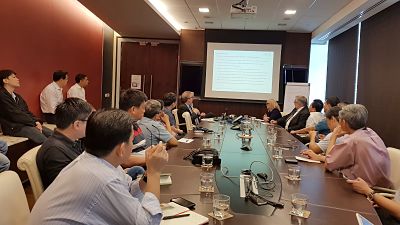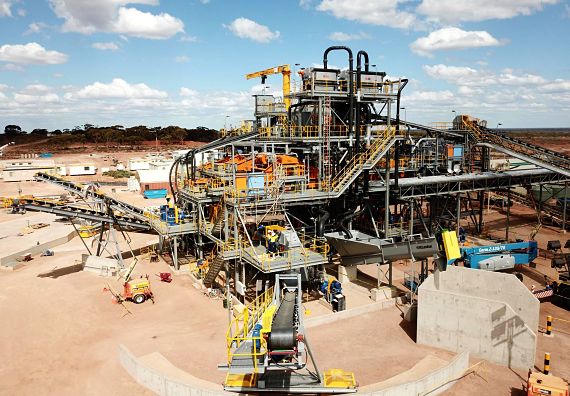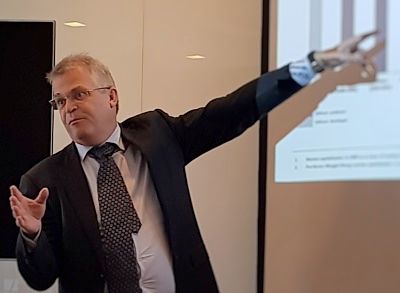Senior management of Alliance Mineral Assets (AMA) and Tawana Resources are in Singapore this week for a series of investor meetings to give updates on the operations of the Bald Hill Project in Western Australia which the two companies co-own.  @ Maybank Kim Eng: Mark Calderwood, Pauline Gately, Mark Turner. NextInsight photo. We attended one meeting yesterday where they, notably, also highlighted the benefits of the merger of the two companies. @ Maybank Kim Eng: Mark Calderwood, Pauline Gately, Mark Turner. NextInsight photo. We attended one meeting yesterday where they, notably, also highlighted the benefits of the merger of the two companies. Shareholders of both companies are expected to vote in favour of the merger scheme in EGMs this month (21 Sept and 26 Sept, respectively).
Post-merger, assuming shareholder approval, the stock will be dual listed as "Alliance Mineral Assets" in Singapore and Australia. With a proforma market capitalisation of over $400 million, it will likely enjoy a re-rating and attract more analyst coverage (see table for other positives). |
Here are 8 takeaways from a Q&A session and discussion at Maybank Kim Eng that we attended:
#1 Quality of Bald Hill spodumene: "The level of iron in our spodumene – iron is one of the key dislikes of converters -- we have only 0.5-0.6% iron. In their concentrates, other Aussie spodumene producers have 2%, so at the moment so we are quite a standout in terms of the quality of the lithium concentrate.
"We have low levels of sodium and potassium and we're averaging 6% lithium concentrate which the other mines (in Australia) can't do at the moment."
-- Mark Calderwood, MD, Tawana.
#2 Ramping up: "The good thing is, our processing plant which was designed for 160 tonnes per has been operating at over 200 tonnes per hour. The plant is running at above name plate and we're looking at a fines circuit to increase production rates. When we install the fines circuit probably by the middle of next year, the total production will be 300 tonnes per hour."
-- Mark Calderwood, MD, Tawana. Bald Hill Project in Western Australia: Produces lithium concentrate and tantalum. Photo: Company
Bald Hill Project in Western Australia: Produces lithium concentrate and tantalum. Photo: Company
#3 Faithful payment by offtaker: "Burwill has given a LC (letter of credit) in advance of a shipment and we pick up 95 cents on the dollar straight away. They put an LC in place up to 30 days in advance, so it's funded before the ship leaves. No product leaves without being paid for."
-- Mark Calderwood, MD, Tawana.
#4 Using free cashflow: "From now until the middle of next year, any free cash we have will go into mining. We will reinvest into pre-strip and into capital expenditure for the fines circuit.
"For the next 12 months, we'll be mining at twice the life-of-the-mine average. The year after, we will start slowing down the mining."
-- Mark Calderwood, MD, Tawana.
#5 Higher strip ratio: "Because the ore body plunges down and as you mine it, you take bigger and bigger strips, so you get that ore up and exposed to keep your mine going.
"The average strip ratio is 10 units of waste for one unit of ore but over the next 12 months, we're going to mine at 17-20 units of waste to one unit of ore to expose the ore to keep continuity of production. Over the life of the project, the average strip ratio is 10 to 1."
-- Mark Turner, non-executive chairman designate of AMA post-merger.
#6 Fines circuit: "The capex for a fines circuit is A$10 - 15 million, it's not a big expenditure. At this time, we don't need a second DMS circuit if we can get the existing one running at up to 300 tonnes per hour, which is nearly twice the original name plate capacity."
-- Mark Calderwood, MD, Tawana.
|
In various global stock exchanges, battery mineral stocks have slid in recent months along with lithium carbonate prices. Other dampening factors include concerns over an oversupply of lithium before an upswing in electric car production materialises.
-- Mark Calderwood, MD, Tawana. |
The PowerPoint presentation is here.







